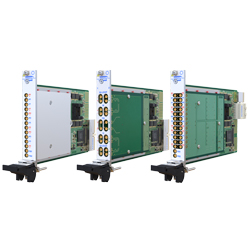
Pickering Interfaces extend the range of protocols supported by 1000Base-T1 PXI and PXIe fault insertion switch modules. Compact single-slot 40/42-203 and 40/42-204 modules offer high performance, switching to 200V and 0.8a, with typical differential bandwidths of 1.6GHz and 700MHz, respectively, providing suitable overhead from the 1000base-t1 specification. These modules provide PXI or PXIe control interfaces, allowing flexible chassis selection.
The new module has a different number of channels and two failed bus connections. The 40-203 (PXI) and 42-203 (PXIe) units allow insertion failures on up to six 2-wire connection channels, while the dual MUX 40-204 (PXI) and 42-204 (PXIe) allow insertion failures on one or two 2-wire connection channels. Both models offer a 100 ohm controlled transmission line impedance signal path. 40/42-204 series is based on high quality electromechanical relay series, long service life. The 40/42-203 series uses high-quality reed relays for high frequency applications,
This release provides partial padding options for the flexibility of smaller test applications, with three channels available for 40/42-203 and 40/42-204 as a single channel. If the test requires an increase, the fully filled module doubles the number of channels to 6 and 2 in the same single chassis slot footprint. Both ranges use the MMCX connector interface to make the high channel count in a small panel area, although there is no difference.
Steve Edwards, Switching Product Manager at Pickering Interfaces, commented, "Originally developed for the automotive market, 1000Base-T1 is also used for industrial controls and building infrastructure Ethernet installations. In the automotive market, the minimum weight of cable with single difference that can achieve high data rates is a requirement of modern vehicles. Fault insertion enables the user to simulate one or two broken cables in each pair of differential wires. In addition, two fault bus connections allow the application of power tracks such as ground or battery and injection of differential pairs for other signal or short circuit conditions. Due to the diversity of target industries, we believe these fail-insert products will have many applications in a variety of ATE systems." The 40/42-204 module provides new functionality for the Pickering fault insert range, which is able to route differential pairs to/from external components of the test device. "